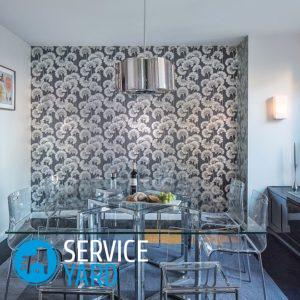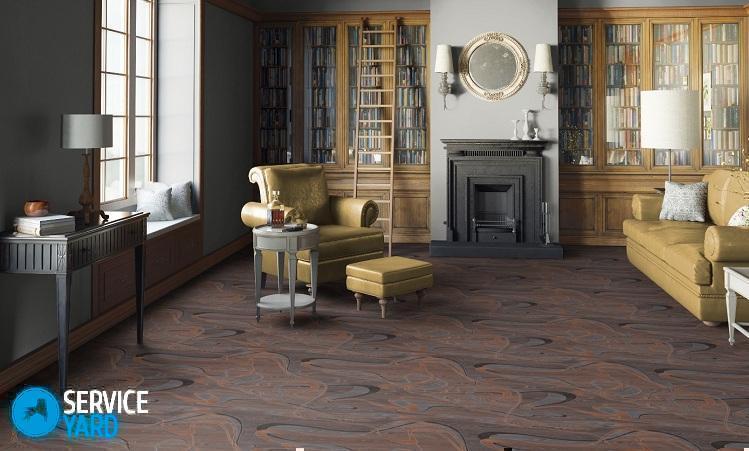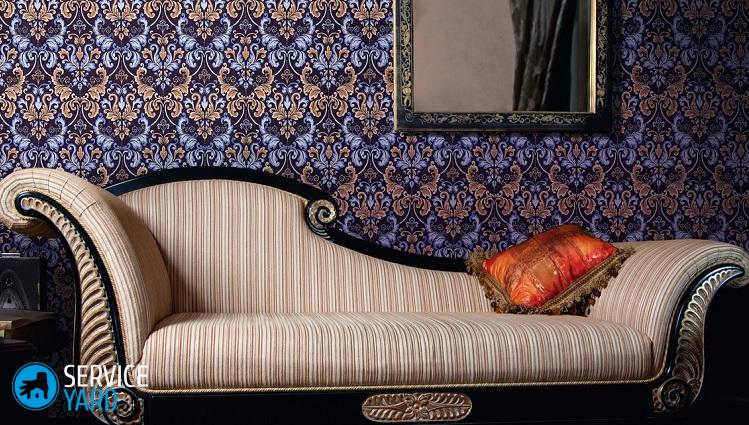Is it possible to glue wallpaper on chipboard?

Many people who face repair work face a lot of inconvenience. Most of the problems are related to the alignment of walls and the installation of partitions, because for this they use more often chipboard and fiberboard. Particleboard is in great demand, even despite the fact that it contains resins containing formaldehydes that are harmful to health. Thanks to modern technologies, this problem has been practically resolved; today this material can be safely used even when repairing children's rooms. Often, people who started repairs, are faced with the question of whether it is possible to glue wallpaper on chipboard or fiberboard. Today we will try to answer this question, talk about the techniques for performing such work.
to contents ↑Features of the use of fiberboard and particleboard
In principle, wallpaper can be glued to any surface. The only difference is only in their processing, the choice of adhesive and canvas. To understand how the coating of the walls of fiberboard and particleboard occurs, you must first familiarize yourself with the main features and characteristics of these popular materials.
Chipboard
Chipboard is a sheet material, it is made by pressing wood chips under a hot press. The layers are bonded to each other with polymer resins.
Important! Traditionally, sheets have a width of 3 mm in increments of 1 mm. In length, they can be from 1830 to 5680 mm, in width from 1220 to 2500 mm. They are mainly used for furniture and interior decoration.
Varieties of particleboard:
- Laminated chipboard - lined with varnish or melamine film at high temperatures. It is incredibly resistant to moisture differences, characterized by high rates of practicality and aesthetics.
- Extrusion chipboard. In this material, the main components of wood are perpendicular to the main surface. Due to the low wear resistance, low strength during bending, this option is not in great demand. On sale you can find strip, tubular, fire, soundproof extrusion plates. They have a rougher surface, so they do not require additional processing and coatings.
To understand how to glue wallpaper on chipboard or other variations of chipboard, you must first clearly determine what specific material is in front of you. To wallpaper this material, the main thing is to choose the right thickness plates, use the correct installation method.
Fiberboard
Fiberboard is produced by hot pressing wood chips, cellulose fibers, synthetic polymers, which serve to bind all of the above components. Therefore, if you are interested in whether it is possible to glue wallpaper on fiberboard, then with confidence we say yes. Due to the content of cellulose fibers, the material perfectly adheres to the adhesive paper layer of the wallpaper. To perform the procedure, it is enough to adhere to the recommendations of specialists, in particular, they relate to the mandatory sealing of cracks, seams, and gaps between sheets.
to contents ↑Chipboard Wallpapering
Particleboard has an incredibly smooth and durable structure, due to which you can independently repair, install a partition or finish the wall with it. But there are a number of features that should be given special attention so that the process is successful.
Features of the use of chipboard for decoration:
- Given that finishing cannot be done in one piece, the slabs are necessarily cut into several parts. That is why between them there are joints and attachment points with nails or self-tapping screws.
- Plates must be carefully prepared for wallpapering, so that in the future there will not be various unpleasant consequences in the form of blisters and cracks.
Training
Perform the preparatory work first:
- Dry the chipboard thoroughly. Just open the packaging with the material, open all the windows in the room to form a draft.
- As soon as the plates are completely dry, treat them with a primer, seal all the joint seams with putty. Then treat the surface with fine sandpaper, cover with white oil paint.
- Hammer nails as deep as possible into the plates, cover with drying oil or paint to prevent the formation of rust and ugly stains on the walls in the future.
- Seal the joints between the panels with gauze, apply paint on top to strengthen the wall, prevent bloating.
Important! It is imperative to remove the old coating before gluing the wallpaper on the chipboard. A recommendation regarding this point will certainly save you from unpleasant consequences.
List of everything you need
The success of repair work depends on how well you complete the preparation. Remember that you work for yourself, so consider every nuance.
In order to decorate a wall or partition, prepare the following materials:
- A long line.
- Sharp scissors.
- Sharpened paper knife.
- Wiping material.
- Capacity for glue.
- A simple pencil.
- Brush or roller for applying glue.
Important! Naturally, the most important thing is the wallpaper. For chipboard, it is better to choose vinyl or non-woven options, because they are more resistant to deformation, perfectly hide any irregularities on the surfaces.
Particleboard coating
Wallpapering must be done correctly and consistently, so study some helpful suggestions:
- Wallpaper should be glued from the corner closest to the window, then move toward the door.
- Using the building level, it is recommended that two vertical lines be applied to the wall in advance so that they correspond to the strip width. They will allow you to glue the material evenly.
- Fitting the pattern deserves special attention. The strips must be cut off gradually, allowing at least 10 cm for the floor and ceiling to avoid problems.
Important! If there is no pattern or pattern on the wallpaper, then you can cut the entire roll at once into strips of the desired length.
- Glue to pick up is also recommended carefully. So, for example, if you prefer textile or non-woven wallpaper, then glue should be applied directly to the wall. In the case of paper wallpaper, it is applied to both the strip and the wall.
Perform the following procedure:
- Prepare a soft cloth to remove any glue residue.
- Start gluing the wallpaper from top to bottom, with a rag smoothing each strip. When treating the top, gradually straighten the bottom.
- If you choose a thin canvas, then glue the wallpaper with an overlap, if it is dense, then butt.
- Last but not least, go on pasting window and door openings.
Important! Be especially vigilant when pasting a corner, make sure that the strips do not tear, do not spoil.
Using this scheme, you will do all the work efficiently, independently, without consequences.
to contents ↑Covering fiberboard boards with wallpaper
Now it's time to figure out how to glue the wallpaper on the fiberboard. The process itself is not much different from the previous version, but there are certain nuances and differences in the preparatory work relating to the surface.
You need to do the following to paste the wallpaper on the fiberboard:
- If there is an old coating on the walls, be sure to remove it.
- Cover the surface with a deeply penetrating primer mixture, because fiberboard is a material that absorbs moisture well.
- Process attachment points and joints.
- To eliminate defects in the form of differences, dents, chips, plaster surfaces.
- Re-treat the fiberboard with a primer, cover the walls with paper so that the wallpaper better adheres to the surface.
- Then paste over the selected wallpaper according to the already known scheme given in the previous section.
Stock footage
This article positively answers the question of exciting beginner masters whether it is possible to glue wallpaper on particleboard. In addition, you now know how to carry out such varieties of repair work efficiently, correctly and quickly. Good luck in this not so difficult matter!
- How to choose a vacuum cleaner taking into account the characteristics of the house and coatings?
- What to look for when choosing a water delivery
- How to quickly create comfort at home - tips for housewives
- How to choose the perfect TV - useful tips
- What to look for when choosing blinds
- What should be running shoes?
- What useful things can you buy in a hardware store
- Iphone 11 pro max review
- Than iPhone is better than Android smartphones





